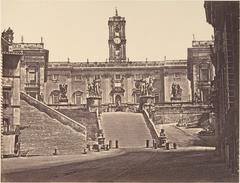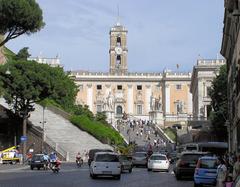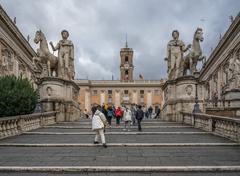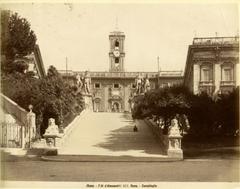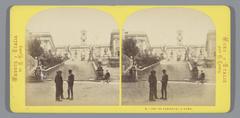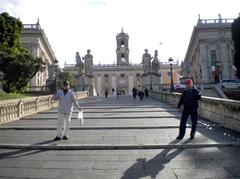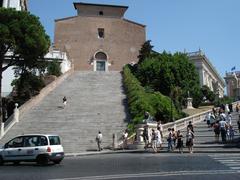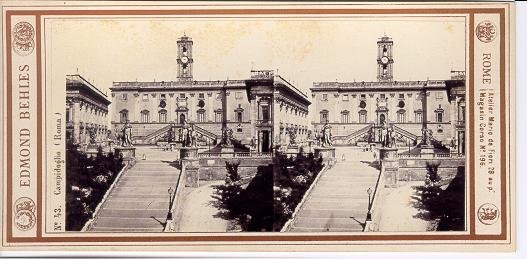
Visiting Hours, Tickets, and Historical Sites of Cordonata in Rome
Date: 23/07/2024
Introduction
The Cordonata, a monumental staircase nestled in the heart of Rome, Italy, stands as a testament to the city’s rich historical and architectural heritage. Designed by the illustrious Renaissance artist Michelangelo Buonarroti, this grand staircase was commissioned by Pope Paul III in the mid-16th century as part of an ambitious urban revitalization project aimed at restoring the grandeur of Rome’s Capitoline Hill (Rome.net). The Cordonata’s gentle incline and wide, shallow steps were an innovative design choice that not only made it accessible for pedestrians and horse-drawn carriages but also exemplified Michelangelo’s commitment to creating a harmonious and functional urban landscape (Capitoline Museums). Over the centuries, the Cordonata has evolved into a vital part of Rome’s urban fabric, serving as a primary access route to the Capitoline Hill, which houses significant institutions such as the Capitoline Museums and the Rome City Hall. This iconic staircase has not only retained its functional significance, but has also become a symbol of Rome’s Renaissance revival, influencing urban planning and architecture worldwide (Encyclopaedia Britannica). Visitors to Rome are often drawn to the Cordonata for its architectural beauty, historical significance, and cultural impact, making it a must-visit destination for anyone seeking to explore the rich tapestry of Rome’s history.
Table of Contents
- Origins and Construction
- Architectural Features
- Historical Significance
- The Cordonata in Modern Times
- Cultural Impact
- Preservation Efforts
- Visitor Experience
- Visiting Hours
- Ticket Prices
- Travel Tips
- Nearby Attractions
- FAQ
Cordonata Staircase in Rome - Visiting Hours, Tickets, and Historical Significance
Origins and Construction
The Cordonata, a monumental staircase in Rome, Italy, was designed by the renowned Renaissance artist and architect Michelangelo Buonarroti. Commissioned by Pope Paul III in the mid-16th century, the Cordonata was constructed between 1548 and 1550. The staircase was part of a larger urban project aimed at revitalizing the Capitoline Hill, one of Rome’s seven hills and a site of immense historical and political significance. The Cordonata was specifically designed to provide a grand and accessible approach to the Piazza del Campidoglio, the redesigned civic center of Rome (Rome.net).
Architectural Features
Michelangelo’s design for the Cordonata was innovative and functional. Unlike traditional staircases, the Cordonata features a gentle incline with wide, shallow steps, making it accessible for both pedestrians and horse-drawn carriages. This design choice reflects Michelangelo’s understanding of the practical needs of the time, as well as his commitment to creating a harmonious and aesthetically pleasing urban landscape. The staircase is flanked by balustrades and adorned with statues, including the famous statues of Castor and Pollux at the top, which were added later in the 16th century (Capitoline Museums).
Historical Significance
The Cordonata holds a prominent place in the history of Rome, both as a physical structure and as a symbol of the city’s Renaissance revival. The staircase was part of Pope Paul III’s broader efforts to restore Rome’s grandeur following the devastation of the Sack of Rome in 1527. By commissioning Michelangelo to redesign the Capitoline Hill, the Pope aimed to create a civic center that would reflect the city’s historical importance and its aspirations for the future. The Cordonata, with its elegant design and strategic location, played a crucial role in this vision (Encyclopaedia Britannica).
The Cordonata in Modern Times
Over the centuries, the Cordonata has remained a vital part of Rome’s urban fabric. It continues to serve as a primary access route to the Capitoline Hill, which houses important institutions such as the Capitoline Museums and the Rome City Hall. The staircase has also become a popular tourist attraction, drawing visitors from around the world who come to admire its architectural beauty and historical significance. In recent years, efforts have been made to preserve and restore the Cordonata, ensuring that it remains a testament to Michelangelo’s genius and Rome’s enduring legacy (Rome Tourism).
Cultural Impact
The Cordonata has not only served a practical purpose but has also had a significant cultural impact. It has been featured in numerous works of art, literature, and film, symbolizing the grandeur and historical depth of Rome. The staircase’s design has influenced urban planning and architecture in other cities, showcasing the lasting legacy of Michelangelo’s work. The Cordonata’s blend of functionality and beauty continues to inspire architects and designers, making it a timeless piece of Rome’s architectural heritage (Artstor).
Preservation Efforts
Given its historical and cultural importance, the Cordonata has been the focus of various preservation efforts. These initiatives aim to protect the staircase from the wear and tear caused by time and the elements, as well as the impact of heavy tourist traffic. Restoration projects have included cleaning and repairing the stone steps, reinforcing the balustrades, and conserving the statues that adorn the staircase. These efforts are crucial in ensuring that the Cordonata remains an integral part of Rome’s historical landscape for future generations to appreciate (UNESCO).
Visitor Experience
For visitors to Rome, the Cordonata offers a unique opportunity to experience a piece of Renaissance history firsthand. Walking up the staircase, one can appreciate the skill and vision of Michelangelo, as well as the historical context in which the Cordonata was built. The staircase provides a dramatic approach to the Capitoline Hill, offering stunning views of the surrounding city. Visitors can also explore the nearby Capitoline Museums, which house an extensive collection of art and artifacts from Rome’s rich history (Rome.info).
Visiting Hours
The Cordonata is accessible at all hours, but the best time to visit is during daylight to fully appreciate its architectural beauty and the surrounding views. The Capitoline Museums, located at the top of the Cordonata, are open daily from 9:30 AM to 7:30 PM, except on major holidays.
Ticket Prices
There is no entrance fee to walk up the Cordonata. However, if you plan to visit the Capitoline Museums, ticket prices are approximately €15 for adults, with discounts available for students and seniors. It’s advisable to check the official website for the most current pricing and any special exhibitions that may affect ticket costs.
Travel Tips
- Best Time to Visit: Early morning or late afternoon to avoid the crowds and enjoy cooler temperatures.
- Photography: The top of the Cordonata offers excellent photo opportunities, especially with the statues of Castor and Pollux in the background.
- Accessibility: The gentle incline of the Cordonata makes it accessible for wheelchairs and strollers, though assistance may be needed in some areas.
- Guided Tours: Consider taking a guided tour to gain deeper insights into the historical and architectural significance of the Cordonata and the surrounding area.
Nearby Attractions
- Roman Forum: A short walk from the Capitoline Hill, offering a glimpse into ancient Rome’s political and social center (Roman Forum).
- Colosseum: Another iconic landmark located nearby, perfect for continuing your historical exploration of Rome (Colosseum).
- Piazza Venezia: Situated at the foot of the Capitoline Hill, featuring the impressive Altare della Patria.
FAQ
What are the visiting hours for the Cordonata?
The Cordonata is accessible 24/7, but daylight hours are recommended for the best experience.
How much are tickets to visit the Cordonata?
There is no fee to visit the Cordonata. However, tickets for the Capitoline Museums at the top cost around €15 for adults.
Is the Cordonata wheelchair accessible?
Yes, the gentle incline makes it accessible, but some assistance may be required in certain areas.
Conclusion
The Cordonata is more than just a staircase; it is a symbol of Rome’s resilience, creativity, and historical significance. Designed by Michelangelo and commissioned by Pope Paul III, the Cordonata has stood the test of time, continuing to serve as a functional and beautiful part of Rome’s urban landscape. Its historical and cultural impact, combined with ongoing preservation efforts, ensures that the Cordonata will remain a cherished landmark for generations to come. Visitors to Rome should not miss the opportunity to experience this remarkable piece of Renaissance architecture and the rich history it represents. For more updates and information, download the Audiala app and follow us on social media.

